Milk & Cookies & Two Mice with Sergio Ruzzier
 September 15th, 2015 by jules
September 15th, 2015 by jules
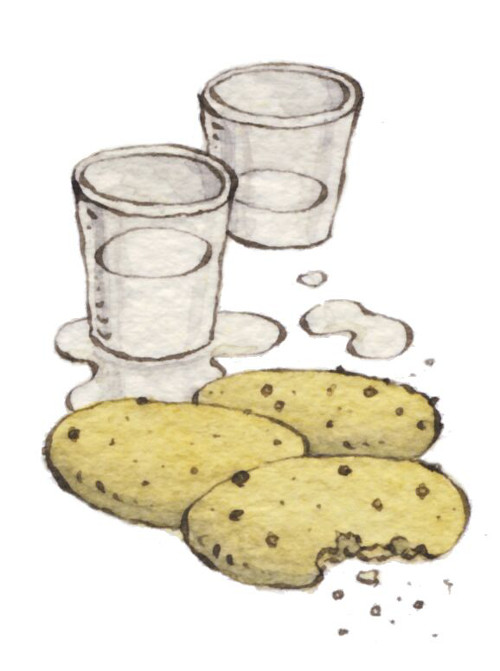
That’s right. Instead of breakfast, I’m having some cookies and milk today. The above image is the back cover illustration for the new picture book from Sergio Ruzzier, Two Mice (Clarion, September 2015).
I’ve found myself saying lately about a small handful of books, “this is one of my favorite picture books of 2015.” This surprises me, but I guess it shouldn’t, since it’s nearly Fall. Two Mice is on that list. A big story of adventure corralled into a small trim size, just right for tiny hands, it’s this perfectly-contained little universe from Ruzzier, who I think has one of the most distinctive styles of any illustrator working in children’s literature today. The very spare text itself consists of a highly-pleasing number pattern (1-2-3, 3-2-1) all throughout, making it an engaging math puzzler for preschoolers, especially those first beginning to read, and the story is thrilling and cozy all at once.
Sergio visits 7-Imp today to talk about that text and to share some of his watercolors from the book (including some preliminary images). I thank him for visiting.
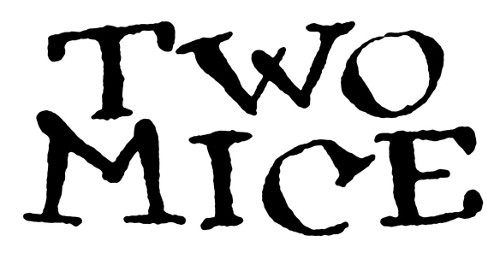
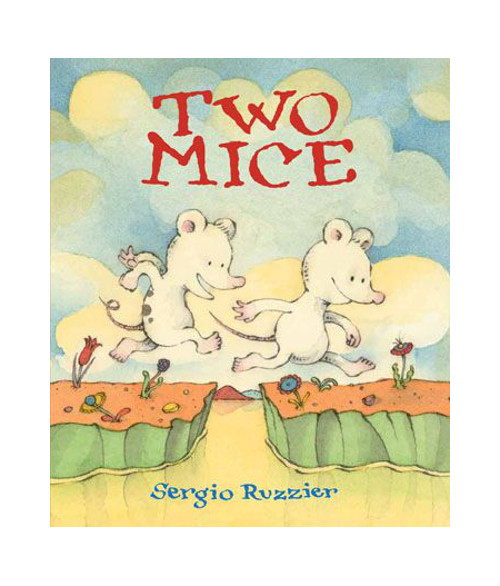
Jules: Hi, Sergio!
One thing I’m curious about: It takes a long time to make something with this impressive brevity. How many drafts did you go through?
Sergio: Two Mice has probably the simplest text among my books, but it was by far the most difficult to write, as you guessed. I got to the final version by stages.
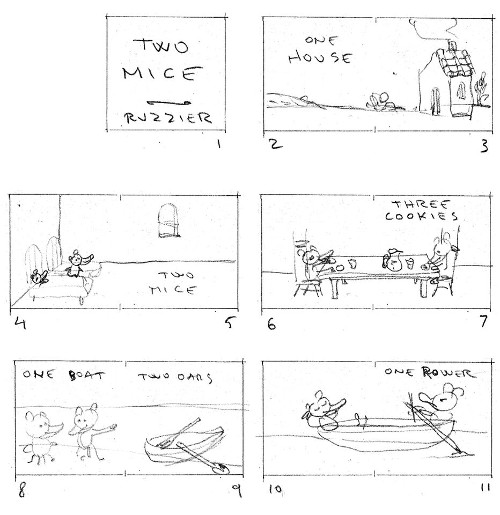
(Click to enlarge)
At first, I simply wanted to write an adventure that would also work as a counting book. A classic 1-to-10 counting storybook. I knew and loved Geisert’s Pigs from 1 to 10 and [Satoshi] Kitamura’s When Sheep Cannot Sleep, and I aimed at something similar. The first draft began with “One nice morning / Two small mice / Eat three cookies. / Then wear four skates / And fall five times.” And so on. It was cute, but it felt very predictable, predictably.

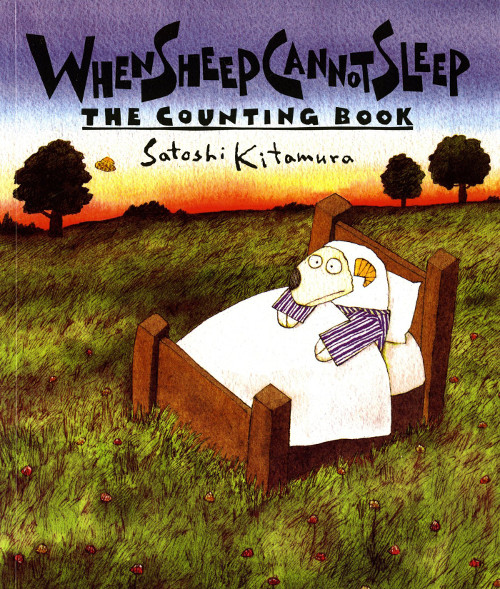
That’s when I started to think that I should find a structure to invite more unexpected twists. So, I thought, what if after 3 I go back to 1? And then back to 3 again? That would give me a more suited pattern to follow the ups and downs of the two mice’s story, which meanwhile was evolving in my mind in terms of content. At the same time, I felt that as simple as the text was, it was not simple enough. So, I got rid of the unnecessary adjectives and kept each line of only two words. It was not easy, though, to find the right words and the right events for that 1-2-3, 3-2-1 template. It was actually very tricky. That made me consider that I could still play with those numbers but that I could avoid a strict, regular sequence. Something like 1-3-2, 2-1-3, etc. But that’s when my editor, Dinah Stevenson, steered me back to the regular sequence. I thought I couldn’t pull it off, honestly, but when I finally solved the puzzle, I was very grateful she insisted so forcibly.
and title page spread with title in blue
(Click last two images to enlarge)
Jules: Wasn’t it Benjamin Franklin who said, “I don’t have time to be brief”? The history of this manuscript goes to show that — and how much every word counts in a picture book. And how it’s a lot, for this reason, like writing poetry.
Incidentally, I love how on the title page spread, in which you show the two mice getting out of bed, you can see in the room a mouse hole in the wall. Do the mice have mice?
Sergio: They might have little humans. Who knows!
Jules: I think that should be your next book.
The other unpredictability I love is the moment of danger, where readers see the mice nearly become supper for some birds. Did you intentionally set out to include some danger and possible destruction?

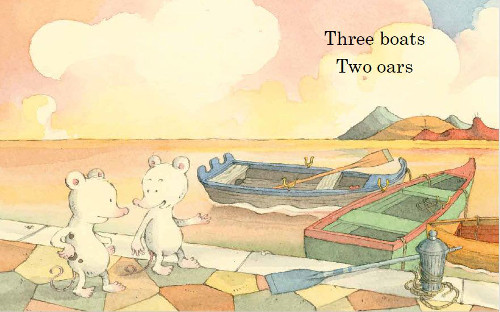
(Click second image to enlarge)
Sergio: Yes, there are a few risky situations in the book. I didn’t intentionally plan them from the start, but I didn’t censor myself either. They happened while writing and sketching the story. But in an adventure like this, you need a little bit of suspense; otherwise, it can get boring. I still hear Maurice Sendak’s voice that demands: Make it dangerous!

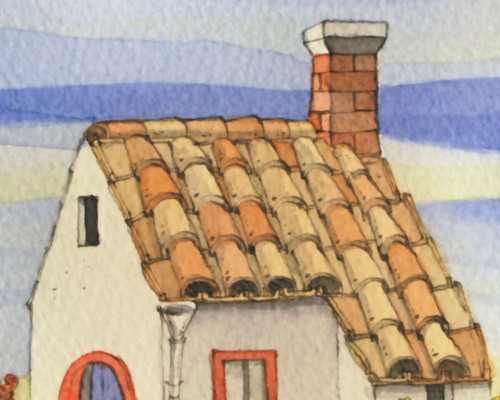
(Click second image to enlarge)
Jules: Last time we chatted, speaking of Sendak, you talked about slipping in a tribute to him in A Letter for Leo. The last page of Two Mice made me think of Chicken Soup with Rice. Was that intentional? I see that the Kirkus review notes the same thing — rather, that you are perhaps giving a visual nod to Max.
I might sound like a crazy person, looking for Sendak in all of your work, but I thought it wouldn’t be out of the realm of possibility that this particular illustration honors him.
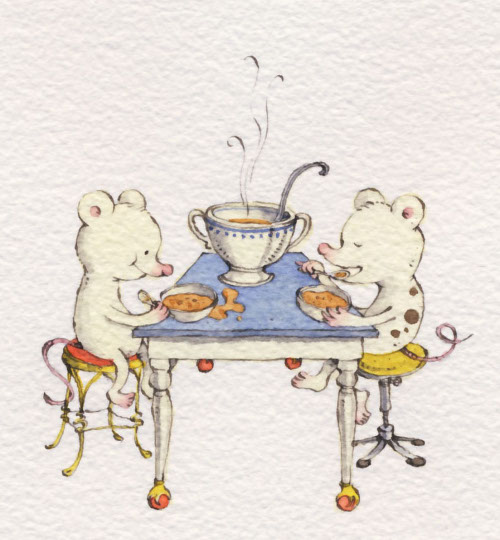
Sergio: It’s interesting to see how many soups there are in Sendak’s work. I did think of him when I wrote the soup episode, even though it’s not as direct an homage as the one in A Letter for Leo. To be precise, this particular soup I nod to is Little Bear’s Birthday Soup, in which each guest brings a different ingredient. Since I was a little kid, I’ve always found that story tender and comforting.

Jules: I like to see picture books with patterns done well, like this one. Speaking from a very utilitarian viewpoint (as the school librarian I once was), they also assist children just learning about reading. I wonder: Do you remember learning to read and the first books you explored, as a child in Italy?
Sergio: With the risk of sounding repetitive, I’ll have to mention the Little Bear series again, which I read of course in the Italian edition. It was my absolute favorite, both for Else Holmelund Minarik’s words and for Sendak’s drawings. I was not what was considered a good reader as a kid, but I didn’t have any problem reading those books, which were beautifully produced, by the way. (Unfortunately, more recent Italian editions were simply horrible.) The paper was wonderful to touch; the size was just right; the drawings were reproduced with such care that you could see every single line of the delicate pen-and-ink crosshatching.

Production is not a secondary element when it comes to books for little children. The sensory experience is fundamental, even more so at a young age, and publishers should always be sensitive to this issue. It hurts me when I hear people saying: little children need big, bold pictures with bright colors on shiny paper. Why?! Children in general see quite well, compared to grown-ups, and can certainly appreciate sophistication, which is not a bad word.
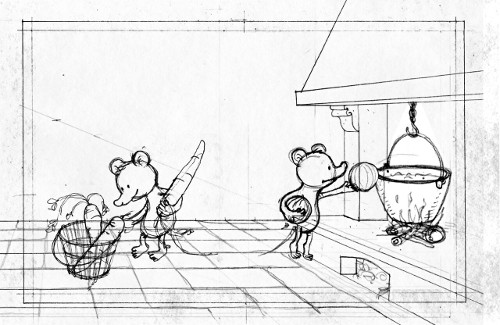

(Click each to enlarge)
Jules: What are some favorite new picture books you’ve read lately or even new artists whose work you love to see — whether overseas or not?
Sergio: You already know of my fondness for Rowboat Watkins. I am very happy more and more people are getting to know and appreciate his work.
Another extraordinary and peculiar artist is Gerardo Blumenkrantz, who was chosen by Maurice as one of the three 2012 Sendak fellows. Unfortunately, they never got the opportunity to meet in person, but I’m sure Maurice would have loved him as much as he was intrigued by his work. I like artists who create a whole personal universe, something both Rowboat and Gerardo do beautifully.
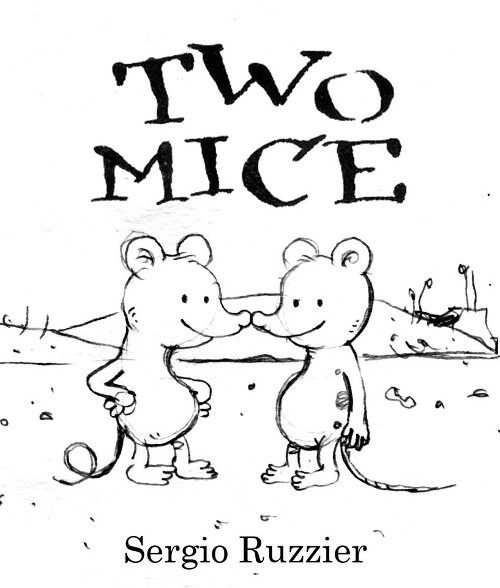
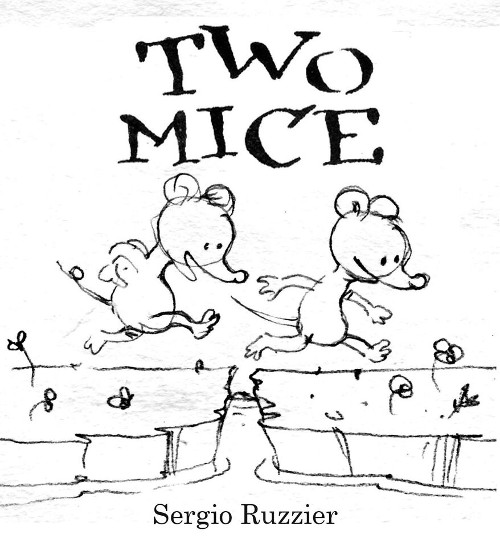
(Click each to enlarge)
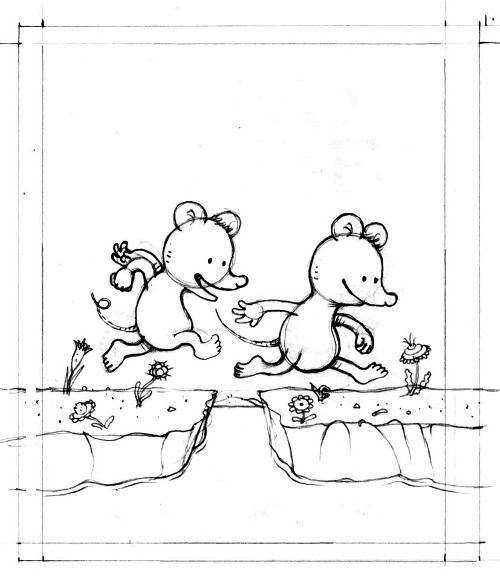
Jules: I am eager to see what Rowboat does next. We had this chat back in April, and I enjoyed talking to him. He is so smart and observant that I want to print out his emails and wallpaper my office with them. … And thanks for the link to Gerardo’s site.
Back to Two Mice: Have you done school visits, by chance, for this book? It’s so perfect for preschoolers and even toddlers. I have read it many times to groups of very young children. I did so a couple weeks ago, in fact, at Parnassus Books in Nashville. Each time I’ve read it, the children are taken by it. They love the details, and I love to ask them about the overriding number pattern (though I never use that phrase and though I’m generally reluctant to ever interrupt a story).
And every time I hold it, I’m so pleased by its trim size. Was that your decision — to have this contained story of three numbers … well, contained in such a small and tidy format?
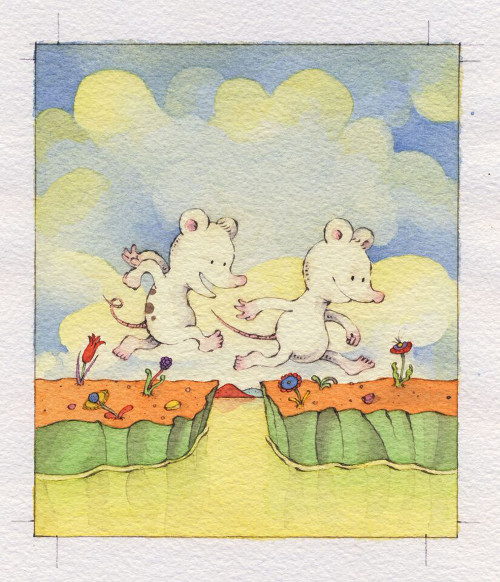

(Click each to enlarge)
Sergio: Two Mice just came out, so I didn’t have many chances to read it in the classroom yet. (School in New York just started this past week.) But yesterday I did my first bookstore reading at BookCourt in Brooklyn. Something I did on the audience’s request was to read it over and over and faster and faster. You can do that with this book because the text is so brief. It worked really well, and I plan to do that with school children, asking them to read it that way. When you do that, you realize that the faster you hear the story, the better you get the number pattern (without using that phrase, as you wisely point out). And it’s fun.
The small trim size was my intention from the beginning. It’s an intimate story about two small creatures, and I wanted a book that small children can handle easily and carry around — and maybe take to bed with them.
Jules: I love this mental image of a child clutching the book while falling asleep. I do think it’s a splendid book for very young children, one many will fall in love with.
Thanks for visiting again, Sergio.
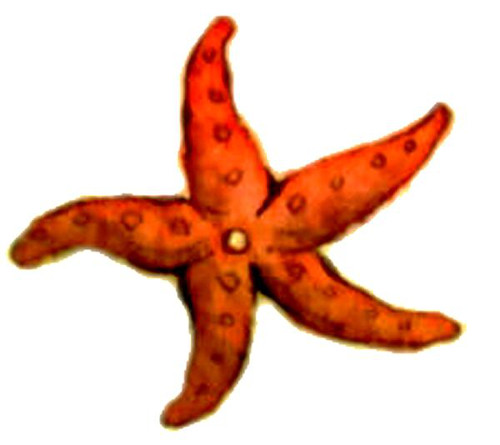
TWO MICE. Copyright © 2015 by Sergio Ruzzier. Published by Clarion Books, Boston. All images reproduced by permission of Sergio Ruzzier.
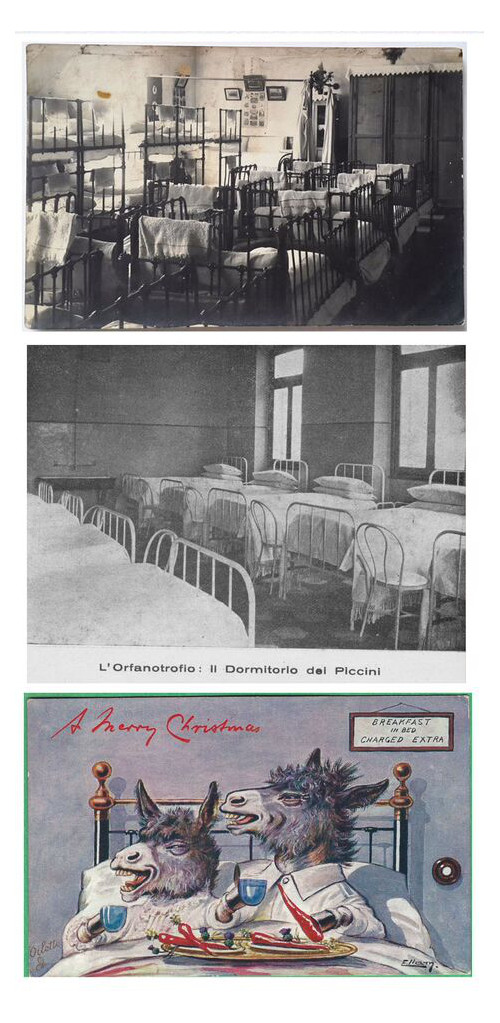
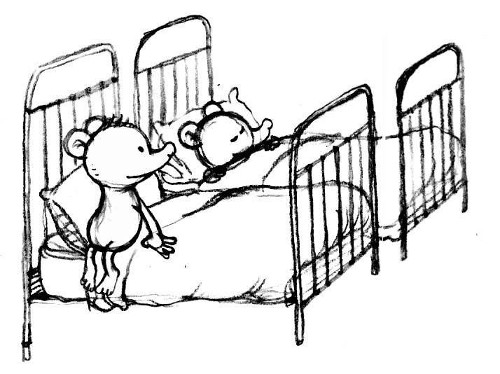
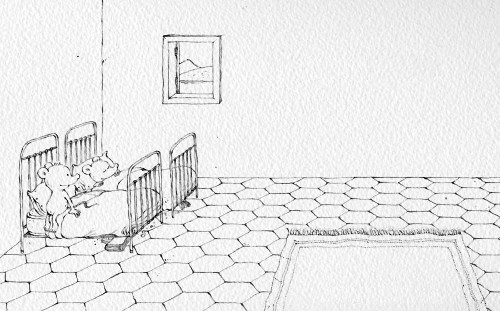
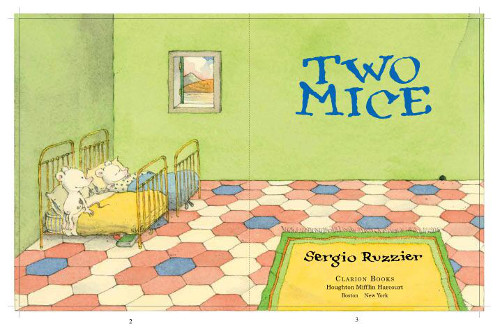

I love this post! I remember you mentioning this book, and now I can’t wait to get my hands on it so I can give it a big hug. 🙂
Sergio Ruzzier is magical! His loving words and is astonishing colors. A true and inspiring master. I really happy that he mentioned “sophistication”. For years before I was published, editors said I was too sophisticated for children’s books. Sergio’s work inspired me that this was not ever true.
I’m being labelled as “too sophisticated” right now! Editors, Agents, please listen to Mr. Ruzzier!!!
I had the exact same experience with the little bear books as a child. Their worth, tenderness and sophistication was so comforting and drew me in like a moth to a flame.
Hello to Sergio and the mice, and to Jules, and to Little Bear! 🙂
I am still wildly curious about the mouse hole on the title page!